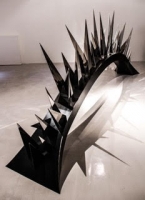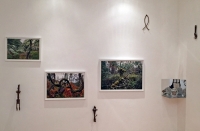Montoro12 is pleased to present Diritta Via, a solo exhibition by Elaine Byrne. In this new body of work, Byrne has created sculptures, photography and video that serve as critiques of power structures, posing specific questions around corruption and the apathy manifested by its victims.
The exhibition title comes from Dante Alighieri’s Divine Comedy where his journey begins in a dark wood (selva oscura). Unable to find the ‘straight way’ (diritta via) to salvation, Dante is conscious that he is ruining himself. Passing though Purgatory he comes to the 8th circle of hell, and encounters corrupt politicians being punished for the crime for which Dante himself was falsely charged when he was forced into exile.
____
It is believed that Dante used medieval accounts from pilgrimages to Saint’s Island on Lough Derg, in Ireland as inspiration for the Inferno. Know as St Patrick’s Purgatory, from the 12th-15th century the island and Ireland were synonymous; it was one of the key reasons any foreigner would travel to Ireland. Saint’s Island was a gateway to the otherworld, pilgrims who spent a night in the Purgatory cave would converse with the dead and battle with demons. If they survived the ordeal their sins were forgiven and they got a free pass to Heaven.
____
Travelling to Saints Island in search of the medieval gate to Purgatory, Byrne examines contemporary notions of corruption and punishment through 14th century pilgrims’ text of the ordeals in Purgatory, contemporary corruption charges and appropriated films, highlighting the punishments for corruption as recounted by the pilgrim. Central to the installation is a 14ft steel sculpture, referencing both the bridge of razors encountered by pilgrims in Purgatory, and a range of important philosophical constructs: the bridge as a test and testimony originating in Persian eschatological symbolism, to be crossed only by the worthy.
_____





